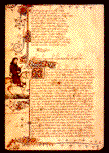 Canterbury Tales
is written sometime between 1387 and Chaucer's death in 1400.
Canterbury Tales
is written sometime between 1387 and Chaucer's death in 1400.
The first European university was founded in Bologna, Italy in 1119. Universities were established in Siena in 1203 and Vincenza in 1204. By the end of the 13th century, universities had been established in Paris, Bologna, Padua, Ghent, Oxford, Cambridge. These were major sites for the institution of a new relationship to books, to learning, and to the Word of God.
These were important institutions because, prior to the advent and rise of the university, learning in Europe had been dominated by the Roman Catholic Church. With the advent of the secular university, students were no longer studying for the clergy. While some students were still from the aristocracy, others were the people who lived in the cities where the universities were located, who had time to attend lectures and take part in the intellectual life of the university.
In many cases, the university consisted of lecturers who lived in the town. If a group of people wanted a class they would go hire a lecturer and pay him to give a series of lectures.
The shift from a religious focus on the next world and the worship of God to a secular focus on the present world and an interest in the natural world. Merchants have different interests from priests.
These new centers of learning created new demands for books. These students didn't have access to the books locked away in monastaries. so they had no access to books. With the rise of this new form of learning, they needed access to new kinds of books not readily available - e.g. non-religious texts.
So the university created a system of demand for books as well as a system for the use of books in ways not used with religious texts.
This effect of the university on book production is what Febvre and Martin take as more revolutionary than the advent of the printing press.
Two new kinds of institutions grew up around the universities to provide for that demand: stationers and book copiers. These folks provided paper and libraries of text books that had been carefully studied and compared to other books for accuracy. They made these books available for copying by students. When a student needed a text for a class, he would go down to the stationers and copy them - by hand. Or he could pay a book copier to copy the book for him.
There are several problems with this mode of book production. The most obvious is that inaccuracies get introduced as the book gets copied.
Second, stationers may try to get accurate copies of the texts, but they have no way to really know how accurate their copies were.
The combination of these factors lead to a compounding of inaccuracies in the texts people used. Mistakes get compounded as copiers get tired, bored, or simply pass along mistakes they don't catch.
But this also created a snowball effect that led to more demand for books well in advance of the advent of the printing press's ability to meet that demand.
Books needed were not just religious texts so much as books on more secular subjects:
The first book on Surgery, the Chirurgi Magna was written in 1363.
 Canterbury Tales
is written sometime between 1387 and Chaucer's death in 1400.
Canterbury Tales
is written sometime between 1387 and Chaucer's death in 1400.
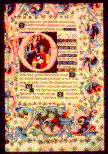 It is also possible to see the beginning of the shift to secular
concerns in religious works. The themes of the works are still
religious but the secular world is beginning to intrude on the
borders.
It is also possible to see the beginning of the shift to secular
concerns in religious works. The themes of the works are still
religious but the secular world is beginning to intrude on the
borders.
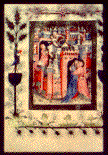 Even quasi-religious books begin to show non-religious aspects of
life: more realistic looking people and artifacts. The
Visconti Hours
is a 14th century book of hours. "A Book of Hours is a compendium of
devotional texts that takes its name from its one essential text,
the Hours of the Virgin, or more properly the Little Office of the
Blessed Virgin Mary. It is called an 'Hours,' or Horae in
Latin, because it is subdivided into eight parts, one for each of the
'hours' of the liturgical day - Matins, Lauds, Prime, Terce, Sext,
None, Vespers, and Compline"*
Even quasi-religious books begin to show non-religious aspects of
life: more realistic looking people and artifacts. The
Visconti Hours
is a 14th century book of hours. "A Book of Hours is a compendium of
devotional texts that takes its name from its one essential text,
the Hours of the Virgin, or more properly the Little Office of the
Blessed Virgin Mary. It is called an 'Hours,' or Horae in
Latin, because it is subdivided into eight parts, one for each of the
'hours' of the liturgical day - Matins, Lauds, Prime, Terce, Sext,
None, Vespers, and Compline"*
Despite the lack of perspective in the medieval images on these pages, we can see that the book is becoming a repository for naturalistic study of plants and animals. The borders of the pages include images that look like real plants, and there are rabbits at the bottom of "Meeting at the Garden Gate."
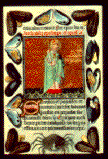 In the Book of Kells
there is an other-worldly truth. In these works, we see a this-worldly
presentation. Similar themes show up in other religious texts.
In the Book of Kells
there is an other-worldly truth. In these works, we see a this-worldly
presentation. Similar themes show up in other religious texts.
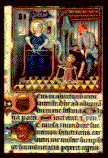 The creators of these works are also beginning to include images of
their own social world. In this manuscript, the
Hours of Catherine of Cleves, produced in 1140,
there is a picture of the Holy Family with Christ in a walker. But
this is not an image of the Roman-era, it is a 15th century image - a
vernacular culture scene - that would look familiar to the reader of
the work.
The creators of these works are also beginning to include images of
their own social world. In this manuscript, the
Hours of Catherine of Cleves, produced in 1140,
there is a picture of the Holy Family with Christ in a walker. But
this is not an image of the Roman-era, it is a 15th century image - a
vernacular culture scene - that would look familiar to the reader of
the work.
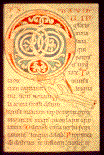 In this period there is also the beginning of the divorce of image from
text/writing. The image here shows the letter "Q" - it is still
decoration, but it looks more like modern decorated text than medieval
text.
In this period there is also the beginning of the divorce of image from
text/writing. The image here shows the letter "Q" - it is still
decoration, but it looks more like modern decorated text than medieval
text.
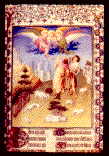 And there is a new kind of realism. Religious images begin to look
more like what we would see today, with a more modern notion of both
perspective and scene - with the sheep and the dogs in the picture with
the angels and the shepherds.
And there is a new kind of realism. Religious images begin to look
more like what we would see today, with a more modern notion of both
perspective and scene - with the sheep and the dogs in the picture with
the angels and the shepherds.
In other texts like the Tacuinum Sanitatis, published in the 10th century, there is a clear image of the real world, without any religious significance. Here we have production and reproduction. From this book people could learn about the real world outside their houses.
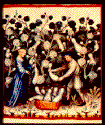
|
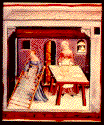
|
|---|---|
| Growing Squash | Making Pasta |
For all the changes in this period, Eisenstein is also correct that the inaccuracies in available texts created problems for the advancement of European knowledge.
First it was difficult to locate books. You could get the books needed for a particular university class, but you might not be able to get your hands on copies of other texts you might need to do independent research.
You were dependent on word of mouth to learn about what books existed, but you may not have any to get copies. Even though there was a shift to secular concerns, copying was not able to meet demand.
In addition, mistakes get compounded as books get made from copies of copies.
Booksellers sought books but had difficult time finding the right ones because most of the world's books were in monasteries, with limited access and very limited cataloging. In most monastaries, many books had been shelved without anyone knowing or marking where.
Eisenstein argues that book production difficulties led to constant rise and decline of learning.
So Eisenstein is right on some points, the rise of the university created a demand, but the technology of the time stifled it as well. Eisenstein, in another work, argues that the early "Italian Renaissance" died as a result of this problem. The universities remained but the original burst of scholarship could not be maintained because the communication system was inadequate to the task.
This page last updated on: Jan 30 1997